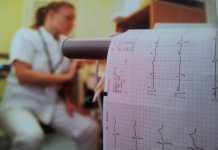April 2003 - People who have had "silent strokes," which have no symptoms, are 8 to 12 percent more likely to have a major debilitating stroke within the following year, researchers have discovered.
In a presentation on April 1, 2003 at the American Academy of Neurology meeting in Hawaii, the investigators reported that if patients had already had a silent stroke, which doctors call a cerebral infarct, they were significantly more likely to have another stroke than patients who had never had an infarct.
Some cerebral infarcts -- the blockage of a cerebral artery -- do not cause symptoms that the patient, family, or even a doctor can recognize without special tests, explained James F. Toole, M.D., Teagle Professor of Neurology at Wake Forest University Baptist Medical Center. This is a silent stroke and parallels the silent heart attack.
"The patient has no symptoms, and the doctor doesn't have the means to identify it," Toole said. "But if you already have had a stroke -- even a silent one -- you have an 8-12 percent risk of having a second one within a year." But the evidence of a cerebral infarct is visible on a CT scan.
The results grew out a major national research study headquartered at Wake Forest University Baptist Medical Center called ACAS (for Asymptomatic Carotid Atherosclerosis Study). The study included 1,659 patients, all of whom had a CT scan both when they entered the study and when they concluded the study.
Continue Reading Below ↓↓↓
The underlying purpose of the study, for which Toole served as national principal investigator, had been to determine whether an operation to clean clogging plaque out of the carotid artery was superior to usual medical treatment. The study was stopped early when it became clear that the operation was superior.
But researchers are still analyzing other aspects of the trial. A neuroradiologist, Thomas A. Tomsick, M.D., of the University of Cincinnati, looked for cerebral infarcts in CT scans taken at the start of the study.
The study found that patients who already had had a cerebral infarct -- silent stroke -- at the start of the study had significantly increased odds that they would have a symptomatic stroke. Having a combination of both diabetes and high cholesterol level also increased stroke risk. This combination also increased the odds that a patient would have a new silent stroke, as did smoking.
But in the ACAS patients, who were regularly examined for up to five years after the study began, other traditional risk factors for stroke didn't seem to matter, including high blood pressure, obesity, percent of the carotid that was blocked beyond 60 percent.
"So we have valid and fresh results from the ACAS study that was completed years ago," said Toole. "Investigators are finding important new results that were not found while ACAS was underway. We accumulated far more data than could be studied. Now the data can be reanalyzed for new results."
Toole said the ACAS results emphasize the importance of doing something quickly about a transient ischemic attack (TIA), which does involve stroke symptoms -- an arm that is temporarily weak or inability to speak for a couple of minutes. The symptoms go away in a short time, and "lots of doctors have minimized the importance of TIAs or waited for recurrence.
"A TIA is a medical emergency," said Toole. "Unless the carotid artery is fixed, there is a likelihood that the patient will have a stroke within the next week or ten days."
The study was supported by the National Institute of Neurological Disorders and Stroke. Besides Toole and Tomsick, the study team included James M. Gebel, M.D., of the University of Pittsburgh, who presented the results at the meeting, Thomas G. Brott, M.D., of the Mayo Clinic in Jacksonville, Fla., Virginia J. Howard, Ph.D., of the University of Alabama at Birmingham and Laura R. Sauerbeck, B.S.N., M.S., of the University of Cincinnati.
Source: Wake Forest University Baptist Medical Center









